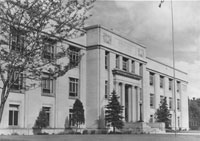Summary 2009 WY 38
Summary of Decision issued March 13, 2009
Summaries are prepared by Law Librarians and are not official statements of the Wyoming Supreme Court.
Case Name: Omohundro v. Sullivan; Sullivan v. Omohundro
Citation: 2009 WY 38
Docket Number: S-08-0027; S-08-0028
Appeal from the District Court of Johnson County, the Honorable David B. Park, Judge.
Representing Appellants Omohundro Trust in case S-08-0027: Kendal Hoopes, Yonkee & Toner, LLP, Sheridan, Wyoming; Anthony T. Wendtland, Wendtland & Wendtland, LLP, Sheridan, Wyoming.
Representing Appellees Sullivan Group in case S-08-0027: Kim P. Cannon and Sasha Johnston, Davis & Cannon, LLP, Sheridan, Wyoming.
Facts/Discussion: Appellants (Omohundro Trusts) own interests in Tract 6 of the Twin Lakes subdivision near Buffalo, Wyoming, and Appellees (Sullivan Group) own Tracts 1-4. The parties dispute whether under the subdivision restrictive covenants, Omohundro Trusts was required to obtain consent from all of the landowners before they could take action which would allow the City of Buffalo to obtain the water rights appurtenant to the subdivision lands. The district court ruled on summary judgment that the restrictive water rights unambiguously required the approval of the owners of all the tracts.
In the document entitled “Covenants for Twin Lakes, Buffalo, Wyoming,” Tracts 1-5 are referred to as Exhibit “A” lands while Tract 6 is referred to as Exhibit “B” lands. The language at the heart of the dispute reads: Notwithstanding any other provision in this declaration, any action, step or procedure (including without limitation, the further subdivision of any lot within the development) or the omission of any act, step or procedure which would allow or entitle the City of Buffalo to take possession, ownership, and control of the irrigation water rights applicable to the development on Exhibit “B” lands as set forth in said attached agreement shall require the written consent and approval of 100% of all lot owners within the development as well as the record owner(s) of Exhibit “B” lands. The Court considers all parts of the covenants in interpreting a provision. The Court stated that by its language the caveat included the recitation paragraphs that Omohundro Trusts claimed should be interpreted as applying to the Exhibit “A” lands. Omohundro Trusts offered the affidavit of William Omohundro as support for its reading of the covenants in its summary judgment action. The Court noted that evidence of the declarants’ subjective intention was not relevant or admissible to interpret the contract, whether its language was ambiguous or not. In addition, the relevant facts and circumstances surrounding the execution of the document could be gleaned from the covenants themselves and the documents attached including the Water Connector’s Agreement with the City.
Conclusion: The Court agreed with the district court that the disputed language unambiguously required the approval of the owners of all the tracts.
Affirmed.
J. Kite delivered the decision.
J. Burke dissented, J. Golden joined: J. Burke disagreed with the majority’s conclusion that the pertinent language in the restrictive covenants was unambiguous. Objectively, the language was ambiguous and subject to differing interpretations regarding the necessity of consent from all Exhibit “A” lot owners before subdivision of Exhibit “B” lands could occur. The interpretation of an ambiguous restrictive covenant raised genuine issues of material fact that precluded summary judgment.
Link: http://tinyurl.com/cjvrst .
[SPECIAL NOTE: This opinion uses the "Universal Citation." It was given an "official" citation when it was issued. You should use this citation whenever you cite the opinion, with a P.3d parallel citation. Please note when you look at the opinion that all of the paragraphs are numbered. When you pinpoint cite to a quote, you should cite to this paragraph number rather than to any page number. If you need assistance in putting together a citation using the Universal Citation form, please contact the Wyoming State Law Library.]


